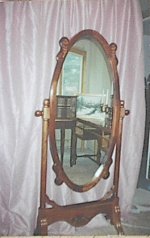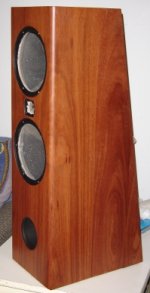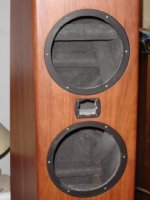I know there are several conventional methods to doing this, namely Staining, Varnishing, Painting, and Veneer. What I'm looking for is something that'll preserve the natural grain of the wood, so I guess staining and varnishing are the only options. However, I want a perfectly smooth finish, and I know I can't do this readily with Varathane, as I can only apply it with a paint brush, not via spraying. Are there any other alternatives? I prefer not to change the colour of the wood. What about oil?
Thanks, Brendan
Thanks, Brendan
Staining refers to the application of the translucent (alcohol stain or water based aniline) or semi-translucent dye on the wood surface (or veneer surface) to correct or change color.
Veneering is the application of the thinly cut wood (veneer) on the sub straight such as MDF or Plywood. It requires technical knowledge, experience and tools.
Pre-veneered panels could be purchased from local supplier for the fraction of the cost of doing it yourself.
Finishing is what preserves a natural beauty of the wood. Varnishing, Lacquering or Oiling.
Oil finishes are easiest to apply and will give you nice smooth finish. They don’t build up fast and yellow with age. Scratch resistance is limited. Chemical resistance is fair.
Other finishes such as Varnish, Brushing lacquer or clear water-based lacquers require a good degree of skill and experience.
Veneering is the application of the thinly cut wood (veneer) on the sub straight such as MDF or Plywood. It requires technical knowledge, experience and tools.
Pre-veneered panels could be purchased from local supplier for the fraction of the cost of doing it yourself.
Finishing is what preserves a natural beauty of the wood. Varnishing, Lacquering or Oiling.
Oil finishes are easiest to apply and will give you nice smooth finish. They don’t build up fast and yellow with age. Scratch resistance is limited. Chemical resistance is fair.
Other finishes such as Varnish, Brushing lacquer or clear water-based lacquers require a good degree of skill and experience.
R-Carpenter said:Staining refers to the application of the translucent (alcohol stain or water based aniline) or semi-translucent dye on the wood surface (or veneer surface) to correct or change color.
Veneering is the application of the thinly cut wood (veneer) on the sub straight such as MDF or Plywood. It requires technical knowledge, experience and tools.
Pre-veneered panels could be purchased from local supplier for the fraction of the cost of doing it yourself.
Finishing is what preserves a natural beauty of the wood. Varnishing, Lacquering or Oiling.
Oil finishes are easiest to apply and will give you nice smooth finish. They don’t build up fast and yellow with age. Scratch resistance is limited. Chemical resistance is fair.
Other finishes such as Varnish, Brushing lacquer or clear water-based lacquers require a good degree of skill and experience.
I realize that, but I'm asking HOW to acquire a totally smooth finish with something like varnish. All of my varnishing has been done with paintbrushes, so any help pertaining to it and paint brushing would help.
Based on the question, I didn’t realize the degree of the understanding, Sorry about it.
I’ve been doing finishing and woodworking for quite a few years and I am not an expert on brushing finishes at all. I’ve never seen a great smooth of the brush finish. Usually they are rubbed out. Rubbing out a finish can vary from simple steel wooling to wet sanding finish from 600 grit to 2000 grit sandpaper. It all depends on the desired sheen (gloss, satin or flat finish) Varnishes also vary in hardness.
I have a fellow on the same floor, who builds boats and an expert on varnishing. I’ll ask him tomorrow.
I think, thinner coats with perhaps nylon brush would be nicer.
Are you looking for a high gloss or matt finish?
I’ve been doing finishing and woodworking for quite a few years and I am not an expert on brushing finishes at all. I’ve never seen a great smooth of the brush finish. Usually they are rubbed out. Rubbing out a finish can vary from simple steel wooling to wet sanding finish from 600 grit to 2000 grit sandpaper. It all depends on the desired sheen (gloss, satin or flat finish) Varnishes also vary in hardness.
I have a fellow on the same floor, who builds boats and an expert on varnishing. I’ll ask him tomorrow.
I think, thinner coats with perhaps nylon brush would be nicer.
Are you looking for a high gloss or matt finish?
Preferably a high gloss. And you don't have to be sorry, sometimes I really suck at explaining stuff...LOL
Brendan
Brendan
Here's a step by step tutorial on French polish: http://www.milburnguitars.com/fpbannerframes.html
Time consuming and takes some practice, but the results are worth it, especially on a project that doesn't get rough treatment (speaker cabinet would be ideal).
Time consuming and takes some practice, but the results are worth it, especially on a project that doesn't get rough treatment (speaker cabinet would be ideal).
If you don't mind, and your friend doesn't mind, could you also ask about satin? I'm building some large floorstanders and the outside will be ply for the most part. Gonna pay for some with a nice face veneer, but no idea what it'll be.R-Carpenter said:
I have a fellow on the same floor, who builds boats and an expert on varnishing. I’ll ask him tomorrow.
I think, thinner coats with perhaps nylon brush would be nicer.
Are you looking for a high gloss or matt finish?
Anybody else that has any suggestions I'd like to hear them too. I'm not very experienced at finishes.
Sorry if I'm threadjacking CS.
It takes about 2 month with an expert guidance to learn French polishing correctly. I remember, I was about 20 years old and worked for Chinese food 8 hours a day just to get to learn from an expert. LOL, this was good old days.
Anyways, these guys are doing a Russian-French school of French Polishing. There’s also an English (British) school. The difference is that the grain is filled with colored plaster of Paris and final coat rubbed out with wax. It's faster.
If you got time, by all means, it’s a beautiful finish. Not at all water or alcohol resistant. Oh, and you could use baby oil.
John, you and shellac?- Debby?! Pastels?
I will ask, Brett.
😀
Anyways, these guys are doing a Russian-French school of French Polishing. There’s also an English (British) school. The difference is that the grain is filled with colored plaster of Paris and final coat rubbed out with wax. It's faster.
If you got time, by all means, it’s a beautiful finish. Not at all water or alcohol resistant. Oh, and you could use baby oil.
John, you and shellac?- Debby?! Pastels?
I will ask, Brett.
😀
Yep.cyberspyder said:Are you also using Baltic Birch?
Thanks.R-Carpenter said:I will ask, Brett.
😀
Hi Cyberspyder. If my guess is right, you're looking for something looking close to piano paint (or lacquer, maybe). I'm not an expert painter, but with tips from a friend I did some years back a small diy project on lacquering a small area of parquet floor. Stain doesn't do the job here. Varnishing by lacquer is the way to go. Steps are as followed:
1. Wood to be sanded down (first by coarse grit sandpaper,
followed by finer grit sandpaper) to get a smooth surface.
2. Wood surface to be cleaned by clean cloth or brush (better still,
vacuum cleaned) to free of any dirt.
3. Find a good lint-free cotton cloth of reasonable size and some
cotton balls.
4. Use the cloth to wrap up the cotton balls to form something like a
Chinese dumpling. Size of this "dumpling" depends on personal
liking (but shouldn't like that of a tennis ball; size of a ping-pong
or slightly larger would be right).
5. Soak this "dumpling" with lacquer and "brush" onto the wood
surface.
6. When the first layer of lacquer is completely dry, sand it carefully
and gently with fine grit sandpaper to get a smooth surface feel.
7. Clean the surface to free of any dirt left by sanding.
8. Apply 2nd layer of lacquer.
9. Repeat steps 6 to 8 for the desired layers.
10.When the last layer is dry, lightly sand to smooth and apply
furniture wax and buff to shine.
Do take note that the above were not done on speaker cabinet but on wood floor. And it is quite a time-consuming job. If you have time, you could give it a shot. Better still, do a try-out on a piece of wood first.
1. Wood to be sanded down (first by coarse grit sandpaper,
followed by finer grit sandpaper) to get a smooth surface.
2. Wood surface to be cleaned by clean cloth or brush (better still,
vacuum cleaned) to free of any dirt.
3. Find a good lint-free cotton cloth of reasonable size and some
cotton balls.
4. Use the cloth to wrap up the cotton balls to form something like a
Chinese dumpling. Size of this "dumpling" depends on personal
liking (but shouldn't like that of a tennis ball; size of a ping-pong
or slightly larger would be right).
5. Soak this "dumpling" with lacquer and "brush" onto the wood
surface.
6. When the first layer of lacquer is completely dry, sand it carefully
and gently with fine grit sandpaper to get a smooth surface feel.
7. Clean the surface to free of any dirt left by sanding.
8. Apply 2nd layer of lacquer.
9. Repeat steps 6 to 8 for the desired layers.
10.When the last layer is dry, lightly sand to smooth and apply
furniture wax and buff to shine.
Do take note that the above were not done on speaker cabinet but on wood floor. And it is quite a time-consuming job. If you have time, you could give it a shot. Better still, do a try-out on a piece of wood first.
http://www.hbehlen.com/
Hey how about a few spray cans? That’s easy and not a lot of money. Beats brushing.
Warning! Flammable!
Hey how about a few spray cans? That’s easy and not a lot of money. Beats brushing.
Warning! Flammable!
R-Carpenter said:
John, you and shellac?- Debby?! Pastels?
Hi Roman,
I went through my shellac period long ago. Can't say I "mastered" the French polish, but I got reasonably good at it and put it to good use on all of the stuff I used to produce, such as this:
Low quality 20 year old photo.
Attachments
http://www.woodcraft.com/family.aspx?FamilyID=751
This is probably going to be most suitable Varnish from the bunch. It’s the harder one.
My friend said that long oil marine varnish are not likely to be a great contend ant for rubbing out to high gloss. It has too much plasticity and it’s a bit too soft. It would be ok for a satin finish.
http://members.aol.com/woodinfo1/brshvar.htm
It is a bit better to apply varnish with a high quality bristle brush.
http://www.woodcraft.com/family.aspx?familyid=5842
Even, run free coats require some practice. It is always better to apply more thinner coats. From my personal experience, always let a coat dry thoroughly. Let it seat over night.
Polishing to a high gloss is much harder then satin.
Here’s link to rubbing out technique. If you have any particular questions, shoot.
I personally like to use hard rubber block for initial sanding.
The important thing to remember is: smother the last coat, easier the rubbing out will be.
http://www.woodcraft.com/family.aspx?familyid=5842
http://www.rockler.com/articles/display_article.cfm?story_id=152
This is probably going to be most suitable Varnish from the bunch. It’s the harder one.
My friend said that long oil marine varnish are not likely to be a great contend ant for rubbing out to high gloss. It has too much plasticity and it’s a bit too soft. It would be ok for a satin finish.
http://members.aol.com/woodinfo1/brshvar.htm
It is a bit better to apply varnish with a high quality bristle brush.
http://www.woodcraft.com/family.aspx?familyid=5842
Even, run free coats require some practice. It is always better to apply more thinner coats. From my personal experience, always let a coat dry thoroughly. Let it seat over night.
Polishing to a high gloss is much harder then satin.
Here’s link to rubbing out technique. If you have any particular questions, shoot.
I personally like to use hard rubber block for initial sanding.
The important thing to remember is: smother the last coat, easier the rubbing out will be.
http://www.woodcraft.com/family.aspx?familyid=5842
http://www.rockler.com/articles/display_article.cfm?story_id=152
Satin
This is a reply more for Brett who asked about satin finish than Cyberspyder.
I veneered a pair of floorstanders a couple of years ago with jarah (an Australian hardwood with lovely mixed red colours). I like the look of an oilfinish but this would not have been practical (fades, picks up dust, shows drink rings etc.) so I finished them in three coats of matt estapol clear single pack polyurethane with a really light sand between coats
http://www.wattyl.com.au/DIY/Products/ProductSearch/Product_Details.htm?Id=454
They came up a treat. Really look like they are oiled. The other great advantage with a matt finish is that it does not show up the imperfections in the surface. After a year or so some very small bumps came up where I had filled over the screws. Very hard to see unless the light is just right.....if I had used a gloss finish they'd stick out like the proverbial dogs....****'*.
Brett, buy a small can and try it on a bit of scrap....
This is a reply more for Brett who asked about satin finish than Cyberspyder.
I veneered a pair of floorstanders a couple of years ago with jarah (an Australian hardwood with lovely mixed red colours). I like the look of an oilfinish but this would not have been practical (fades, picks up dust, shows drink rings etc.) so I finished them in three coats of matt estapol clear single pack polyurethane with a really light sand between coats
http://www.wattyl.com.au/DIY/Products/ProductSearch/Product_Details.htm?Id=454
They came up a treat. Really look like they are oiled. The other great advantage with a matt finish is that it does not show up the imperfections in the surface. After a year or so some very small bumps came up where I had filled over the screws. Very hard to see unless the light is just right.....if I had used a gloss finish they'd stick out like the proverbial dogs....****'*.
Brett, buy a small can and try it on a bit of scrap....
Kimbo thanks. I'll grab a small can and try it when I get the wood.
Jarrah is beautiful, but personally I'm hoping on something more like ash. Love the grain and two of my favourite basses are made from it and will look smashing next to them.
Jarrah is beautiful, but personally I'm hoping on something more like ash. Love the grain and two of my favourite basses are made from it and will look smashing next to them.
hmmm
On fine wood the best Ive seen is to use linseed oil and very very fine steel wool. We used to use that method to finish the KOA cabinets at Cizek back in the 70's.
It brings the grain out and looks fantastic. Just Oil it once a year to keep it spiffy for years to come.
On fine wood the best Ive seen is to use linseed oil and very very fine steel wool. We used to use that method to finish the KOA cabinets at Cizek back in the 70's.
It brings the grain out and looks fantastic. Just Oil it once a year to keep it spiffy for years to come.
Brett....here are a couple of shots to give you the idea.....taken a couple of years ago unfortunately with a flash....the flash makes the finish look glossier than it really is. In natural light or with the normal room light, they appear oiled. If you do try it on a bit of scrap, make sure you give it at least two coats.....the first one pretty much disappears into the timber as a filler coat. Another thing I like about it is that although the matt finish makes it look like the surface is porus, the three coats of estapol is really substantial and everything just wipes off it.
Attachments
hi cyberspyder.have to tried wipe on polyurethane?you can get it at home depot.it takes many coats,but with a little sanding with 600 grit at the end,leaves a very smooth finish.
- Status
- Not open for further replies.
- Home
- Loudspeakers
- Multi-Way
- Speaker Cabinet Finishes


